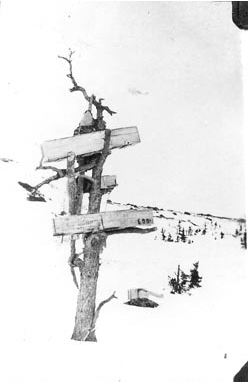Burial tree facts for kids
A burial tree or burial scaffold is a special way people in the past cared for their dead. Instead of burying bodies in the ground, they would place them in trees or on raised platforms. This practice was common among groups like the Balinese, the Naga people, some Aboriginal Australians, and several First Nations in North America.
Contents
First Nations Burial Practices
Many First Nations in North America used burial trees or scaffolds. This was often their usual way to lay a loved one to rest. Sometimes, it was an alternative to burying someone in the ground.
Burial Trees
When using a burial tree, the body was carefully wrapped. This might be in a buffalo robe or blankets. The wrapped body was then placed in a tree fork. Sometimes, it was tied to a strong branch. Both adults and children were laid to rest in this way. A single burial tree could hold more than one person.
Some trees were even painted red on their trunks and branches. Any type of tree could be used. Travelers often mentioned cottonwood trees on the great plains. Pine and cedar trees were also used. Bodies could be placed from about six feet up to near the very top of the tree. Often, some of the person's belongings were placed near the body.
Burial Scaffolds
A burial scaffold was usually built from four tall poles or branches. These poles had forks at the top. This structure held a platform, like a bed, where the body was placed. This kept the body safe from animals like wolves. People often chose to build these scaffolds on a hill. Relatives would place some of the dead person's belongings on the platform or around the scaffold.
The poles usually reached about six to eight feet above the ground. One very tall scaffold for a Sisseton Sioux person was about 18 feet high. Some scaffolds had poles painted with black and red stripes. One traveler in Nebraska in 1849 saw a scaffold made of lodge poles. These poles leaned against each other at the top. It had two platforms halfway down.
An Ojibwe man might have his weapons and other personal items placed with him on the scaffold. Food, eating tools, and tobacco were also included. Sometimes, this method was used as a temporary solution. This happened if someone died far from their usual burial ground. The Ojibwe also used birch bark to wrap bodies instead of animal skins.
In the 18th century, the Choctaw people used scaffolds as the first step in their burial process. Months later, special bone pickers would clean the bones. The cleaned skeleton was then placed into a small coffin. Finally, this coffin was moved to the community's special bone house.
Near Fort Laramie in 1866, an Indian woman's belongings were placed with her. She was in an open pine box on a scaffold. The heads and tails of her two ponies were attached to the scaffold's poles.
Among the Crow people, the dead were wrapped in a robe. They were placed on the platform with their feet facing east. Later, the bones might be collected and placed in a rock crevice.
The Mandan Indians placed bodies on scaffolds with their feet facing southeast. This was to direct the spirit towards their old homeland near Heart River, North Dakota. Once the scaffold broke down, the bones were wrapped in a hide. They were then buried in the village's refuse pile or a riverbank. The skull was often placed with other clan skulls. These skulls were arranged in circles near the scaffolds. Babies who died before being named were not considered full members of the community. They were placed in trees or buried away from the main burial ground.
Why Use Trees and Scaffolds?
There were several reasons why people chose tree or scaffold burials. During winter, the Ponca Indians often used scaffolds. This was because the ground was frozen and hard to dig. A Lakota person explained other reasons:
- Animals or people might walk over graves.
- Bodies in graves could lie in mud and water after rain or snow.
- Wolves might dig up and eat the bodies.
By placing the dead on a scaffold or in a tree, relatives could also feel closer to the person. They believed it was easier to talk to the deceased this way.
Images for kids
-
A funeral scaffold of a Sioux chief. A basket-like cover protects the body. The Cheyennes sometimes used this method too.
Gallery
See also
- Sky burial
- Tower of Silence






